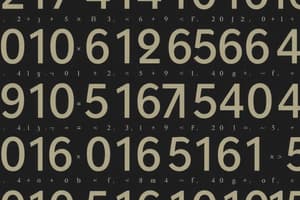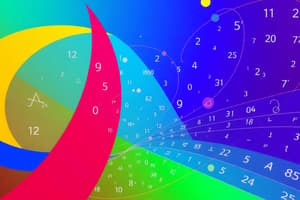Podcast
Questions and Answers
Which tool is best suited for summarizing uploaded files?
Which tool is best suited for summarizing uploaded files?
- Flightrosor
- Gammaai
- Chatpdf.com (correct)
- Chatrpt
Which of the following tools is explicitly designed for creating presentations?
Which of the following tools is explicitly designed for creating presentations?
- Chatpdf.com
- Chatrpt
- Chat Youtube.com
- Gammaai (correct)
If you wanted to analyze live statistics related to Internet activity, which tool is most directly relevant?
If you wanted to analyze live statistics related to Internet activity, which tool is most directly relevant?
- Internate live stats (correct)
- Chatrpt
- Chat youtube.com
- Chatpdf.com
Which option might provide features related to interacting with or discussing content found on YouTube?
Which option might provide features related to interacting with or discussing content found on YouTube?
Considering the options, which one represents a general-purpose conversational AI?
Considering the options, which one represents a general-purpose conversational AI?
Which tool could be used to process and summarize content from a PDF file?
Which tool could be used to process and summarize content from a PDF file?
If you need a tool to quickly generate visual presentations, which of the following options is MOST suitable?
If you need a tool to quickly generate visual presentations, which of the following options is MOST suitable?
Which of the listed tools would be most helpful in gathering real-time data related to internet trends?
Which of the listed tools would be most helpful in gathering real-time data related to internet trends?
To engage in a conversation about videos on YouTube, which dedicated platform would be most appropriate?
To engage in a conversation about videos on YouTube, which dedicated platform would be most appropriate?
If your goal is to have a general conversation with an AI, which tool is most likely designed for that purpose?
If your goal is to have a general conversation with an AI, which tool is most likely designed for that purpose?
Which tool is specifically designed to upload, process, and summarize documents?
Which tool is specifically designed to upload, process, and summarize documents?
Which tool specializes in the automatic creation of presentation slides?
Which tool specializes in the automatic creation of presentation slides?
Which of the following tools would likely provide insights into current Internet trends and statistics?
Which of the following tools would likely provide insights into current Internet trends and statistics?
To engage in discussions about specific YouTube content, which specialized platform should be used?
To engage in discussions about specific YouTube content, which specialized platform should be used?
If you need a versatile AI for engaging in conversations on various topics, which option would be most suitable?
If you need a versatile AI for engaging in conversations on various topics, which option would be most suitable?
Which tool allows a user to upload documents and then receive a concise summary of the content?
Which tool allows a user to upload documents and then receive a concise summary of the content?
For users looking to prepare a presentation efficiently, which tool offers automated presentation creation?
For users looking to prepare a presentation efficiently, which tool offers automated presentation creation?
Which service provides statistics that are updated in real-time about the broader state of the Internet?
Which service provides statistics that are updated in real-time about the broader state of the Internet?
If one wanted to have discussions centered around videos found on YouTube, which platform would be the most focused?
If one wanted to have discussions centered around videos found on YouTube, which platform would be the most focused?
Which tool primarily functions as an AI for conducting general conversations?
Which tool primarily functions as an AI for conducting general conversations?
Flashcards
Internate Live Stats
Internate Live Stats
Explore real-time global internet statistics.
ChatPDF
ChatPDF
A platform to summarization documents by uploading PDFs.
Gamma AI
Gamma AI
Gamma AI is a presentation tool.
ChatYoutube
ChatYoutube
Signup and view all the flashcards
Study Notes
Numerical Sequences: General Information
- A real number sequence is a function u: N -> R
- u(n) = un is the image of integer n by u, and also the general term of sequence u
- Numerical sequences can be defined explicitly as un = f(n) or by recurrence as u(n+1) = f(un), with u0 being given
Numerical Sequences: Examples
- Arithmetic sequence: u(n+1) = un + r
- Geometric sequence: u(n+1) = q * un
Graphical Representation
- The graphical representation of a sequence in an orthogonal coordinate system is the set of points with coordinates (n; un)
- Given a sequence defined by recurrence u(n+1) = f(un), the first terms can be constructed on the x-axis
Variations
- A sequence (un) is increasing if, for all n in N, un ≤ u(n+1)
- A sequence (un) is decreasing if, for all n in N, un ≥ u(n+1)
- A sequence (un) is monotone if it's either increasing or decreasing
Studying the variations
- Study the sign of u(n+1) - un
- If un > 0, compare u(n+1) / un to 1
- If un = f(n), study the variations of the function f
Studying the variations: Examples
- un = n^2 gives the result: u(n+1) - un = (n+1)^2 - n^2 = 2n + 1 > 0, which implies that (un) is increasing
- un = 1/(n+1) becomes u(n+1) - un = -1 / ((n+2)(n+1)) < 0; hence, (un) is decreasing
Majorized, Minorized, and Bounded Sequences
- A sequence (un) is majorized if there exists a real number M such that, for all n in N, un ≤ M
- A sequence (un) is minorized if there exists a real number m such that, for all n in N, un ≥ m
- A sequence (un) is bounded if it is both majorized and minorized
Majorized, Minorized, and Bounded Sequences: Examples
- un = sin(n) is bounded because -1 ≤ un ≤ 1
- un = n^2 is minorized by 0, but not majorized
Limits
Finite Limit
- A sequence (un) converges to a real number l if every open interval containing l contains all un values from a certain rank onward, denoted as lim (n→+∞) un = l
Finite Limit: Example
- un = 1/(n+1), this becomes lim (n→+∞) un = 0
Infinite Limit
- A sequence (un) tends towards +∞ if every interval of the form ]A ; +∞[ contains all un values from a certain rank onward, which can be denoted as lim (n→+∞) un = +∞
- A sequence (un) tends towards -∞ if every interval of the form ]-∞ ; A[ contains all un values from a certain rank onward, which can be denoted as lim (n→+∞) un = -∞
Infinite Limit: Examples
- un = n^2, therefore lim (n→+∞) un = +∞
- un = -n, therefore lim (n→+∞) un = -∞
Operations on limits
- If lim(un) = l and lim(vn) = l', then lim(un + vn) = l + l'
- If lim(un) = l and lim(vn) = +∞, then lim(un + vn) = +∞
- If lim(un) = -∞ and lim(vn) = l, then lim(un + vn) = -∞
- If lim(un) = +∞ and lim(vn) = +∞, then lim(un + vn) = +∞
- If lim(un) = -∞ and lim(vn) = -∞, then lim(un + vn) = -∞
- If lim(un) = +∞ and lim(vn) = -∞, then lim(un + vn) has an indeterminate form
Operations on limits; multiplication
- If lim(un) = l and lim(vn) = l', then lim(un × vn) = l × l'
- If lim(un) = l > 0 and lim(vn) = +∞, then lim(un × vn) = +∞
- If lim(un) = l > 0 and lim(vn) = -∞, then lim(un × vn) = -∞
- If lim(un) = l < 0 and lim(vn) = +∞, then lim(un × vn) = -∞
- If lim(un) = l < 0 and lim(vn) = -∞, then lim(un × vn) = +∞
- If lim(un) = 0 and lim(vn) = ±∞, then lim(un × vn) has an indeterminate form
- If lim(un) = ±∞ and lim(vn) = 0, then lim(un × vn) has an indeterminate form
- If lim(un) = +∞ and lim(vn) = +∞, then lim(un × vn) = +∞
- If lim(un) = -∞ and lim(vn) = -∞, then lim(un × vn) = +∞
- If lim(un) = +∞ and lim(vn) = -∞, then lim(un × vn) = -∞
Operations on limits; division
- If lim(un) = l and lim(vn) = l' ≠ 0, then lim(un / vn) = l / l'
- If lim(un) = l and lim(vn) = ±∞, then lim(un / vn) = 0
- If lim(un) = ±∞ and lim(vn) = l' ≠ 0, then lim(un / vn) = ±∞ (same sign as 1/l')
- If lim(un) = l ≠ 0 and lim(vn) = 0+, then lim(un / vn) = ±∞ (same sign as l)
- If lim(un) = l ≠ 0 and lim(vn) = 0-, then lim(un / vn) = ±∞ (same sign as -l)
- If lim(un) = 0 and lim(vn) = 0, then lim(un / vn) has an indeterminate form
- If lim(un) = ±∞ and lim(vn) = ±∞, then lim(un / vn) has an indeterminate form
Comparison Theorems
- If for all n ≥ p, un ≥ vn and lim (n→+∞) vn = +∞, then lim (n→+∞) un = +∞
- If for all n ≥ p, un ≤ vn and lim (n→+∞) vn = -∞, then lim (n→+∞) un = -∞
Gendarmes Theorem
- If for all n ≥ p, vn ≤ un ≤ wn and lim (n→+∞) vn = lim (n→+∞) wn = l, then lim (n→+∞) un = l
Gendarmes Theorem: example
- With the result of un = sin(n)/n, we know that -1/n ≤ sin(n)/n ≤ 1/n
- As lim (n→+∞) -1/n = 0 and lim (n→+∞) 1/n = 0, therefore lim (n→+∞) sin(n)/n = 0
Sequences and Functions
- If lim (n→+∞) un = +∞ and lim (x→+∞) f(x) = l, then lim (n→+∞) f(un) = l
- If lim (n→+∞) un = l and lim (x→l) f(x) = l', then lim (n→+∞) f(un) = l'
Sequences and Functions examples
- If un = 1/n and f(x) = e^x, then lim (n→+∞) un = 0 and lim (x→0) f(x) = 1
- As a result, lim (n→+∞) e^(1/n) = 1
Particular Sequences
Arithmetic Sequences
- An arithmetic sequence is defined by u(n+1) = un + r, where r is the common difference
- Properties: un = u0 + nr and un = up + (n-p)r
Sum of terms
- S = u0 + u1 + ... + un = (n+1) × (u0 + un) / 2
- S = (number of terms) × (first term + last term) / 2
Arithmetic sequences: example
- 1 + 2 + ... + n = n × (1+n) / 2 = n(n+1) / 2
Geometric Sequences
- A geometric sequence is defined by u(n+1) = q * un, where q is the common ratio
- Properties: un = u0 × q^n and un = up × q^(n-p)
Sum of terms
- If q ≠ 1, S = u0 + u1 + ... + un = u0 × (1-q^(n+1)) / (1-q)
- If q = 1, S = (n+1)u0
Geometric Sequences: example
- 1 + 2 + 4 + 8 + 16 = 1 × (1-2^5) / (1-2) = 31
Limits
- If q > 1, then lim (n→+∞) q^n = +∞
- If q = 1, then lim (n→+∞) q^n = 1
- If -1 < q < 1, then lim (n→+∞) q^n = 0
- If q ≤ -1, then (q^n) has no limit
- lim (n→+∞) a^n / n! = 0
Studying That Suits You
Use AI to generate personalized quizzes and flashcards to suit your learning preferences.




